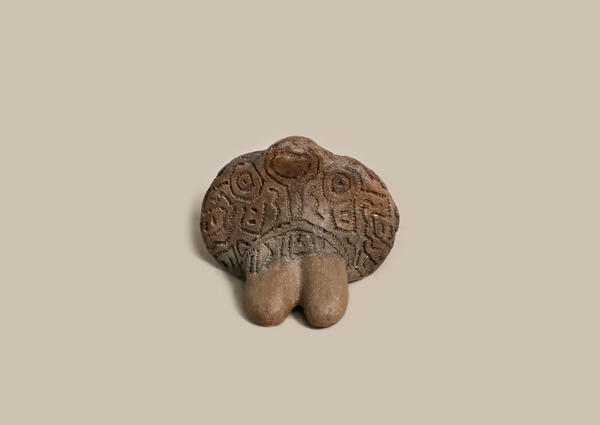There is still no consensus among researchers on the origin of ceramic production in the territory of Western Siberia. Scientists from the Ural Federal University put forward the assumption that the first ceramics appeared there about 8 thousand years ago. They also believe that this craft came from the Far East — the earliest center of pottery. Perhaps, climate change prompted the ancient inhabitants to stock up on food, so they began to mold vessels of clay.
At that time, nomadic tribes were shifting to sedentary life and moved only between winter and summer dwellings. Food was stocked in winter dwellings. Simultaneously with pottery and permanent dugouts, the first ancient settlements encircled by a moat appeared. At that time, people seldom used clay for anything other than vessels.
Clay sculptures, especially anthropomorphic ones, are not often found in excavations. The anthropomorphic sculptures found are all similar. They show a figure of a human sitting in outerwear. The face was either marked schematically or not depicted at all. A hood is often placed on the head. The clothes are covered with ornaments — they were applied with a thin and sharp metal tool. The clay figures were most often found in settlements where people presumably knew how to forge and make similar working tools.
It is still not known precisely what these figurines were used for. Some scientists believe they were used as toys for children. The figurines resemble the traditional Khanty dolls — Akan, which were also made without a face. It was believed that if the toy with eyes was left unattended, it would be possessed by an evil spirit.
Researchers also do not exclude a connection between clay figurines and hearth worship and ritual practices. The hearth worship was found among all the peoples of Siberia. They believed that the hearth was a link between ancestors and descendants, a symbol of intergenerational continuity.
An anthropomorphic clay sculpture from the funds of the History and Art Museum Complex was discovered in 1991 while exploring the territories in the southern part of the Nefteyugansk District on the Tapatiega River. There are several ancient settlements with the same name near this river. The place where this exhibit was found is called Tapatiega 2. Researchers dated this archaeological monument to the 1st millennium BC — the 12th century AD.
At that time, nomadic tribes were shifting to sedentary life and moved only between winter and summer dwellings. Food was stocked in winter dwellings. Simultaneously with pottery and permanent dugouts, the first ancient settlements encircled by a moat appeared. At that time, people seldom used clay for anything other than vessels.
Clay sculptures, especially anthropomorphic ones, are not often found in excavations. The anthropomorphic sculptures found are all similar. They show a figure of a human sitting in outerwear. The face was either marked schematically or not depicted at all. A hood is often placed on the head. The clothes are covered with ornaments — they were applied with a thin and sharp metal tool. The clay figures were most often found in settlements where people presumably knew how to forge and make similar working tools.
It is still not known precisely what these figurines were used for. Some scientists believe they were used as toys for children. The figurines resemble the traditional Khanty dolls — Akan, which were also made without a face. It was believed that if the toy with eyes was left unattended, it would be possessed by an evil spirit.
Researchers also do not exclude a connection between clay figurines and hearth worship and ritual practices. The hearth worship was found among all the peoples of Siberia. They believed that the hearth was a link between ancestors and descendants, a symbol of intergenerational continuity.
An anthropomorphic clay sculpture from the funds of the History and Art Museum Complex was discovered in 1991 while exploring the territories in the southern part of the Nefteyugansk District on the Tapatiega River. There are several ancient settlements with the same name near this river. The place where this exhibit was found is called Tapatiega 2. Researchers dated this archaeological monument to the 1st millennium BC — the 12th century AD.


